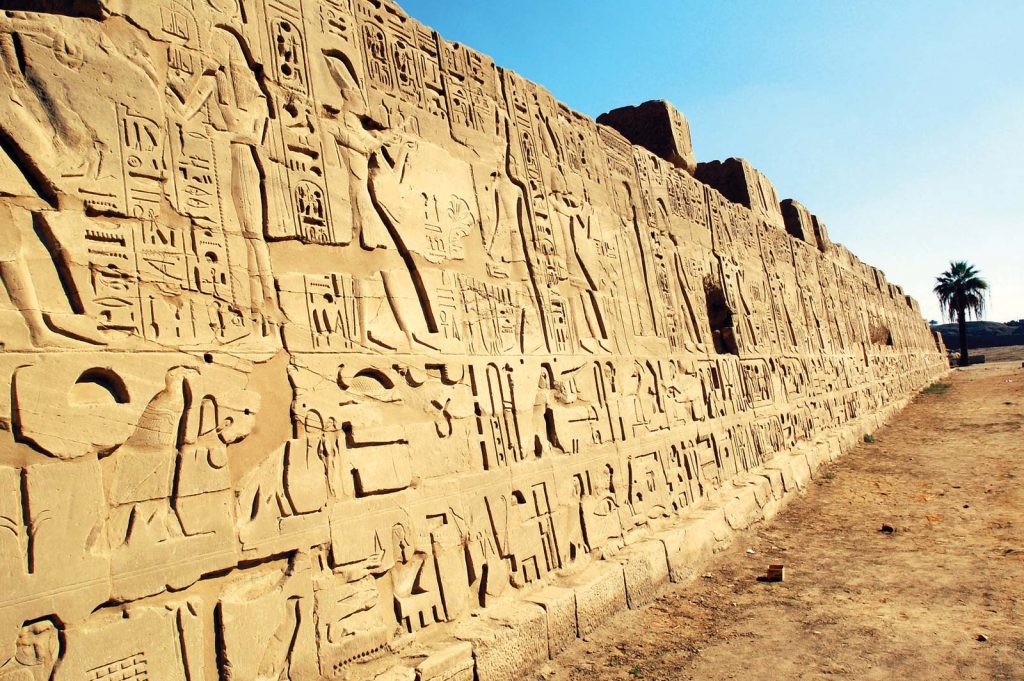Yeah, that is how it looks in today’s realities. Because besides their famous pyramids, mummies, artifacts and so on, that same hieroglyphic script on the same level was Egyptian great inheritance, which opened the door to the further development of the languages, knowledge, civilizations as we can see it today, shedding some light and providing with a legacy which still resonates with people of 21st century.
But let’s start from the beginning.

When you look at the image above, what do you see? This simple and at the same time complicated question forces you to notice some abstract images, forms, shapes that look like something you already envisioned, something alike, right?
Well, the answer is “right”. These symbols represent things that may seem similar to you, being the form of writing, by which people of ancient Egypt (spoiler alert: small percentage) communicated.
It included pictographs or literal representations of something they saw. Same as ideographs or an idea that hides behind the object. Also, some of it was phonograms or rebus, which meant to represent a sound like vowels and syllables.
The bottom line (joking) is that this language is Hieroglyphic script (3,200 BCE – AD 400), which is unique in its own way. The first Egyptian hieroglyphs appeared around the time of King Menes (a pharaoh of the Early Dynastic Period of ancient Egypt) formed the first Egyptian dynasty, that unified the country.
It was hard to learn and eventually use, because of its complex structure of making (writing) and pictorial forms, that is why only a small percentage of people used to have appropriate level expertise, such as priests, nobility or Pharaon.
The translation of the actual word “hieroglyphic” from Greek means “sacred carving”, such meaning does make sense, because the cursive hieroglyphs inscriptions were used in temple walls, public monuments or graves of royals (or wealthy) to guide their souls into the “other world” or to the afterlife. This fact resembles the hieratic scripted papyrus scroll called the Book of the Dead.

This writing system has 1,000 distinct characters. I know, it is a lot, but that is why throughout the time it was distinguished into two other forms of Egyptian writing that were written with ink on papyrus or another smooth surface aside from the stone that used to be the main source of script infliction. “These were known as the hieratic, which was still employed during the time of the ancient Greeks for religious texts, and the demotic, the cursive script used for ordinary documents”, Peter F. Dorman, Britannica.

Before the appearance of hieroglyphs in the history of humanity, there was another ancient writing system, much older, which is called Cuneiform (4,000 – 3,500 BCE). It was depicted on the stones as well, however, with the shaped reeds inscribing (pressing, not dragging) some sort of triangular marks.
Cuneiform, same as hiroglyph shares a script type – logography. Also, from the first glance, they look kind of similar but share some key differences contrasting to the hieroglyphic script, which could be readen right to left, cuneiform does it in opposite direction.
As historians tell us, cuneiform was created by Sumerians (one of the earliest civilizations), who may have created the first cities and religion. Many of the great developments of the bronze and iron ages are thought to have taken place in Sumer, which was a Southern Mesopotamia, Fertile Crescent or today’s Southern Iraq (and parts of Syria; Kuwait).
“Why she is talking about the Cuniform if the topic was about different things?”, you will probably ask yourself. Well, coming back to the Cuniform was an intentional move to emphasize a lean towards practical usefulness developed by ancient progress. Since hieroglyphics nevertheless were the ones that lasted much longer, retaining for almost 3,500 years. And yeah, I am persuaded that it is a real “flex” indeed.

Sources:
https://www.history.com/news/hieroglyphics-facts-ancient-egypt
https://search.credoreference.com/search/all?searchPhrase=Hieroglyphs
https://www.britannica.com/topic/hieroglyphic-writing
https://en.wikipedia.org/wiki/Hieroglyph
https://en.wikipedia.org/wiki/Book_of_the_Dead
Writing note from Patrick
Love the conversational style and clear explanations. Suggest using Grammarly to avoid poorly structured sentences that can distract from an otherwise strong story. Maybe explain in more detail what you mean by “flex.” Good job overall.